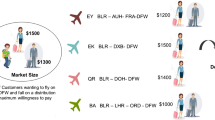Abstract
In recent years, the cruise line industry has become an exciting growth category in the leisure travel market. Like airlines and hotels, it reports all characteristics of revenue management (RM). Although RM has attracted widespread research interest in airline and hotel contexts, studies of cruise line revenue management are very limited. Using data from a major North American cruise company, we apply a variety of (24) forecasting methods, which are divided into three categories (non-pickup methods, classical pickup (CP) methods and advanced pickup (AP) methods), to generate forecasts of final bookings for the cruises that have not yet departed at a particular reading point. We use a two-stage framework to test alternative forecasting methods and compare their performance. We found the performance of multiplicative methods to be significantly worse. Among the additive methods, we find that classical methods perform the best, followed by AP and non-pickup methods. All CP methods with the exception of exponential smoothing with trend perform fairly well. Among AP methods, Autoregressive integrated moving average, linear regression and moving average (MA) produce the most accurate forecasts. Within non-pickup methods, MA is the most effective method.







Similar content being viewed by others
Notes
For confidentiality reasons, we cannot disclose the name of company and related details.
Reading point is certain point of time that is of interest to us. At this point, some cruises have already departed and others are yet to depart.
We use the term time-series method to refer to a method wherein future bookings are computed as a weighted average of past bookings. The time dimension is only captured through separate cruises (each represented by a distinct cruise ID) departing at different weeks.
We use the term causal forecasting method to refer to a method wherein future bookings are expressed as a function of bookings on hand.
References
Ahmed, Z.U., Johnson, J.P., Ling, C.P., Fang, T.W. and Hui, A.K. (2002) Country-of-origin and brand effects on consumers’ evaluations of cruise lines. International Marketing Review 19 (2/3): 279–302.
Biehn, N. (2006) A cruise ship is not a floating hotel. Journal of Revenue and Pricing Management 5 (2): 135–142.
Box, G.E.P. and Jenkins, G.M. (1970) Time Series Analysis, Forecasting and Control. San Francisco, CA: Holden Day.
Chen, C. and Kachani, S. (2007) Forecasting and optimisation for hotel revenue management. Journal of Revenue and Pricing Management 6 (3): 163–174.
Duman, T. and Mattila, A.S. (2005) The role of affective factors on perceived cruise vacation value. Tourism Management 26: 311–323.
Dwyer, L. and Forsyth, P. (1998) Economic significance of cruise tourism. Annals of Tourism Research 25 (2): 393–415.
Gorin, T.O. (2000) Airline revenue management: Sell-up and forecasting algorithms. Master’s thesis, Massachusetts Institute of Technology.
Ji, L. and Mazzarella, J. (2007) Application of modified nested and dynamic class allocation models for cruise line revenue management. Journal of Revenue and Pricing Management 6 (1): 19–32.
Kimes, S.E. (1989) Yield management: A tool for capacity-considered service firms. Journal of Operations Management 8 (4): 348–363.
Ladany, S.P. and Arbel, A. (1991) Optimal cruise-liner passenger cabin pricing policy. European Journal of Operational Research 55 (2): 136–147.
Lee, A.O. (1990) Airline reservations forecasting: Probabilistic and statistical models of the booking process. PhD dissertation, Massachusetts Institute of Technology.
Lieberman, W.H. and Dieck, T. (2002) Expanding the revenue management frontier: Optimal air planning in the cruise industry. Journal of Revenue and Pricing Management 1 (1): 7–24.
Littlewood, K. (1972) Forecasting and control of passenger bookings. Proceedings of the 12th Annual AGIFORS Symposium; Nathanya, Israel, Vol. 12, pp. 95–117, reprinted in Journal of Revenue and Pricing Management, 4 (2): 111–123.
Marti, B.E. (2004) Trends in world and extended-length cruising (1985–2002). Marine Policy 28 (3): 199–211.
McGill, J.I. and Van Ryzin, G.J. (1999) Revenue management: Research overview and prospects. Transportation Science 33 (2): 233–256.
Qu, H. and Ping, E.W.Y. (1999) A service performance model of Hong Kong cruise travelers’ motivation factors and satisfaction. Tourism Management 20: 237–244.
Petrick, J.F. (2004) Are loyal visitors desired visitors? Tourism Management 25: 463–470.
Petrick, J.F. (2005) Segmenting cruise passengers with price sensitivity. Tourism Management 26: 753–762.
Reyes, M.H. (2006) Hybrid forecasting for airline yield management in semi-restricted fare structures. Master’s thesis, Massachusetts Institute of Technology.
Sa, J. (1987) Reservation forecasting in airline yield management. Master’s thesis, Massachusetts Institute of Technology.
Skwarek, D.K. (1996) Competitive impacts of yield management system components: forecasting and sell-up models. Master’s thesis, Massachusetts Institute of Technology.
Talluri, K. and van Ryzin, J. (2004) The Theory and Practice of Revenue Management. Boston, MA: Kluwer Academic.
Teye, V.B. and Leclerc, D. (1998) Product and service delivery satisfaction among North American cruise passengers. Tourism Management 19 (2): 153–160.
Toh, R.S., Rivers, M.J. and Ling, T.W. (2005) Room occupancies: Cruise lines out-do the hotels. International Journal of Hospitality Management 24 (1): 121–135.
Weatherford, L.R. (1998) Forecasting issues in revenue management. In: Presentation at Spring INFORMS Conference, Montreal, Canada.
Weatherford, L.R. and Kimes, S.E. (2003) A comparison of forecasting methods for hotel revenue management. International Journal of Forecasting 19 (3): 401–415.
Weatherford, L.R., Kimes, S.E. and Scott, D.A. (2001) Forecasting for hotel revenue management: Testing aggregation against disaggregation. Cornell Hotel and Restaurant Administration Quarterly 42: 53–64.
Wickham, R.R. (1995) Evaluation of forecasting techniques for short-term demand of air transportation. Master’s thesis, Massachusetts Institute of Technology.
Wie, B.-W. (2004) Open-loop and closed-loop models of dynamic oligopoly in the cruise line industry. Asia-Pacific Journal of Operational Research 21 (4): 517–541.
Zeni, R.H. (2001) Improved forecast accuracy in revenue management by unconstraining demand estimates from censored data. PhD dissertation, ProQuest Information and Learning Company.
Zickus, J.S. (1998) Forecasting for airline network revenue management: Revenue and competitive impacts. Master’s thesis, Massachusetts Institute of Technology.
Author information
Authors and Affiliations
Rights and permissions
About this article
Cite this article
Sun, X., Gauri, D. & Webster, S. Forecasting for cruise line revenue management. J Revenue Pricing Manag 10, 306–324 (2011). https://doi.org/10.1057/rpm.2009.55
Received:
Revised:
Published:
Issue Date:
DOI: https://doi.org/10.1057/rpm.2009.55




